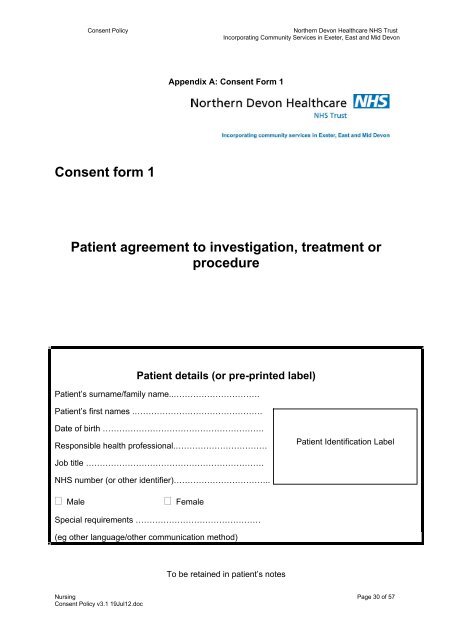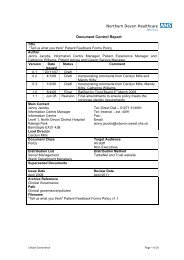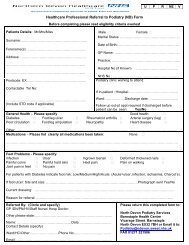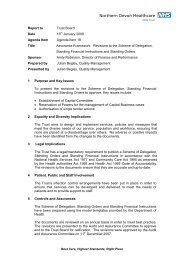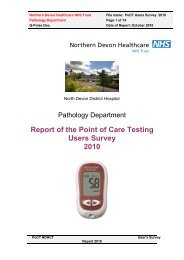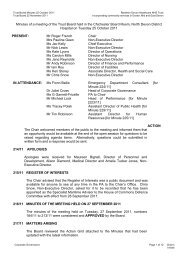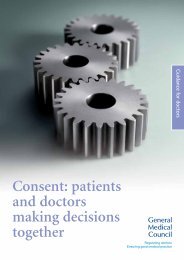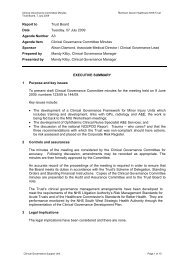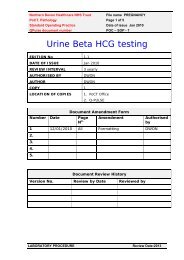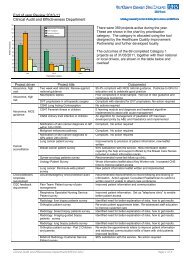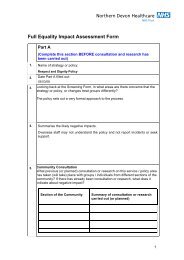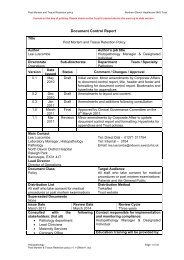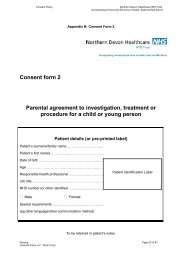Consent form 1 Patient agreement to investigation, treatment or ...
Consent form 1 Patient agreement to investigation, treatment or ...
Consent form 1 Patient agreement to investigation, treatment or ...
- No tags were found...
Create successful ePaper yourself
Turn your PDF publications into a flip-book with our unique Google optimized e-Paper software.
<strong>Consent</strong> PolicyN<strong>or</strong>thern Devon Healthcare NHS TrustInc<strong>or</strong>p<strong>or</strong>ating Community Services in Exeter, East and Mid DevonAppendix A: <strong>Consent</strong> F<strong>or</strong>m 1<strong>Consent</strong> <strong>f<strong>or</strong>m</strong> 1<strong>Patient</strong> <strong>agreement</strong> <strong>to</strong> <strong>investigation</strong>, <strong>treatment</strong> <strong>or</strong>procedure<strong>Patient</strong> details (<strong>or</strong> pre-printed label)<strong>Patient</strong>’s surname/family name..………………………….<strong>Patient</strong>’s first names .……………………………………….Date of birth ………………………………………………….Responsible health professional.……………………………<strong>Patient</strong> Identification LabelJob title ……………………………………………………….NHS number (<strong>or</strong> other identifier)……………………………..MaleFemaleSpecial requirements ………………………………………(eg other language/other communication method)To be retained in patient’s notesNursing Page 30 of 57<strong>Consent</strong> Policy v3.1 19Jul12.doc
<strong>Consent</strong> PolicyN<strong>or</strong>thern Devon Healthcare NHS TrustInc<strong>or</strong>p<strong>or</strong>ating Community Services in Exeter, East and Mid Devon<strong>Patient</strong> identifier/labelName of proposed procedure <strong>or</strong> course of <strong>treatment</strong> (include brief explanation if medical termnot clear)…………………………………………………………………….……………………………………..…………………………………………………………………………………………………………………………………………………………………………………………………………………………Statement of health professional (<strong>to</strong> be filled in by health professional with appropriateknowledge of proposed procedure, as specified in consent policy)I have explained the procedure <strong>to</strong> the patient. In particular, I have explained:The intended benefits……………………………………………………………..……….………………………………………………………………………………………………………………………………………………………………………..…………………………..………………………………………………………...Serious <strong>or</strong> frequently occurring risks……………………………………………...……………….………………………………………………………………………………………….…………………………………………….………………………………………………..……………………………………………………………………….Any extra procedures which may become necessary during the procedureblood transfusion…………………………………..…….……………………………………….other procedure (please specify) ………………………………...……...…………….…..…….I have also discussed what the procedure is likely <strong>to</strong> involve, the benefits and risks of anyavailable alternative <strong>treatment</strong>s (including no <strong>treatment</strong>) and any particular concerns of thispatient.The following leaflet/tape has been provided ……………….…………………………..…This procedure will involve:general and/<strong>or</strong> regional anaesthesia local anaesthesia sedationSigned:…….……………………………………Name (PRINT) ………………………. ………Date .. …………………….……….Job title …….. ………………….…Contact details (if patient wishes <strong>to</strong> discuss options later) …..……………….……………Statement of interpreter (where appropriate)I have interpreted the in<strong>f<strong>or</strong>m</strong>ation above <strong>to</strong> the patient <strong>to</strong> the best of my ability and in a way inwhich I believe s/he can understand.Signed ………………………….……………………. Date ………………..…………….Name (PRINT) …………………..………………………………………………………………Nursing Page 31 of 57<strong>Consent</strong> Policy v3.1 19Jul12.doc
<strong>Consent</strong> PolicyN<strong>or</strong>thern Devon Healthcare NHS TrustInc<strong>or</strong>p<strong>or</strong>ating Community Services in Exeter, East and Mid DevonOriginal sheet accepted by patient: yes/no (please ring)Statement of patient<strong>Patient</strong> identifier/labelPlease read this <strong>f<strong>or</strong>m</strong> carefully. If your <strong>treatment</strong> has been planned in advance, you shouldalready have your own copy of page 2 which describes the benefits and risks of the proposed<strong>treatment</strong>. If not, you will be offered a copy now. If you have any further questions, do ask –we are here <strong>to</strong> help you. You have the right <strong>to</strong> change your mind at any time, including afteryou have signed this <strong>f<strong>or</strong>m</strong>.I agree <strong>to</strong> the procedure <strong>or</strong> course of <strong>treatment</strong> described on this <strong>f<strong>or</strong>m</strong>.I understand that you cannot give me a guarantee that a particular person will per<strong>f<strong>or</strong>m</strong> theprocedure. The person will, however, have appropriate experience.I understand that I will have the opp<strong>or</strong>tunity <strong>to</strong> discuss the details of anaesthesia with ananaesthetist bef<strong>or</strong>e the procedure, unless the urgency of my situation prevents this. (This onlyapplies <strong>to</strong> patients having general <strong>or</strong> regional anaesthesia.)I understand that any procedure in addition <strong>to</strong> those described on this <strong>f<strong>or</strong>m</strong> will only becarried out if it is necessary <strong>to</strong> save my life <strong>or</strong> <strong>to</strong> prevent serious harm <strong>to</strong> my health.I have been <strong>to</strong>ld about additional procedures which may become necessary during my<strong>treatment</strong>. I have listed below any procedures which I do not wish <strong>to</strong> be carried out withoutfurther discussion. …………………………………………………………………………………….…………………………………………………………………………………………………………………………………………………………………………………………………………………………<strong>Patient</strong>’s signature …………………………………………..Date…………………………..Name (PRINT) ………………………………………………………………………………………A witness should sign below if the patient is unable <strong>to</strong> sign but has indicated his <strong>or</strong> herconsent. Young people/children may also like a parent <strong>to</strong> sign here (see notes).Signature ……………………………………………Date ……………………..….………Name (PRINT) ………………………………………………………………………………….…Confirmation of consent (<strong>to</strong> be completed by a health professional when the patient isadmitted f<strong>or</strong> the procedure, if the patient has signed the <strong>f<strong>or</strong>m</strong> in advance)On behalf of the team treating the patient, I have confirmed with the patient that s/he has nofurther questions and wishes the procedure <strong>to</strong> go ahead.Signed:…….……………………………………Name (PRINT) ………………………. ………Date .. …………………….……….Job title …….. ………………….…Imp<strong>or</strong>tant notes: (tick if applicable)See also advance directive/living will (eg Jehovah’s Witness <strong>f<strong>or</strong>m</strong>)<strong>Patient</strong> has withdrawn consent (ask patient <strong>to</strong> sign /date here) ……………...……….Nursing Page 32 of 57<strong>Consent</strong> Policy v3.1 19Jul12.doc
<strong>Consent</strong> PolicyN<strong>or</strong>thern Devon Healthcare NHS TrustInc<strong>or</strong>p<strong>or</strong>ating Community Services in Exeter, East and Mid DevonGuidance <strong>to</strong> health professionals (<strong>to</strong> be read in conjunction with <strong>Consent</strong> policy)What a consent <strong>f<strong>or</strong>m</strong> is f<strong>or</strong>This <strong>f<strong>or</strong>m</strong> documents the patient’s <strong>agreement</strong> <strong>to</strong> go ahead with the <strong>investigation</strong> <strong>or</strong> <strong>treatment</strong>you have proposed. It is not a legal waiver – if patients, f<strong>or</strong> example, do not receive enoughin<strong>f<strong>or</strong>m</strong>ation on which <strong>to</strong> base their decision, then the consent may not be valid, even thoughthe <strong>f<strong>or</strong>m</strong> has been signed. <strong>Patient</strong>s are also entitled <strong>to</strong> change their mind after signing the<strong>f<strong>or</strong>m</strong>, if they retain capacity <strong>to</strong> do so. The <strong>f<strong>or</strong>m</strong> should act as an aide-memoire <strong>to</strong> healthprofessionals and patients, by providing a check-list of the kind of in<strong>f<strong>or</strong>m</strong>ation patients shouldbe offered, and by enabling the patient <strong>to</strong> have a written rec<strong>or</strong>d of the main points discussed.In no way, however, should the written in<strong>f<strong>or</strong>m</strong>ation provided f<strong>or</strong> the patient be regarded as asubstitute f<strong>or</strong> face-<strong>to</strong>-face discussions with the patient.The law on consentSee the Department of Health’s Reference guide <strong>to</strong> consent f<strong>or</strong> examination <strong>or</strong> <strong>treatment</strong> f<strong>or</strong> acomprehensive summary of the law on consent (also available at www.doh.gov.uk/consent).Who can give consentEveryone aged 16 <strong>or</strong> m<strong>or</strong>e is presumed <strong>to</strong> be competent <strong>to</strong> give consent f<strong>or</strong> themselves,unless the opposite is demonstrated. If a child under the age of 16 has “sufficientunderstanding and intelligence <strong>to</strong> enable him <strong>or</strong> her <strong>to</strong> understand fully what is proposed”, thenhe <strong>or</strong> she will be competent <strong>to</strong> give consent f<strong>or</strong> himself <strong>or</strong> herself. Young people aged 16 and17, and legally ‘competent’ younger children, may theref<strong>or</strong>e sign this <strong>f<strong>or</strong>m</strong> f<strong>or</strong> themselves, butmay like a parent <strong>to</strong> countersign as well. If the child is not able <strong>to</strong> give consent f<strong>or</strong> himself <strong>or</strong>herself, some-one with parental responsibility may do so on their behalf and a separate <strong>f<strong>or</strong>m</strong> isavailable f<strong>or</strong> this purpose. Even where a child is able <strong>to</strong> give consent f<strong>or</strong> himself <strong>or</strong> herself, youshould always involve those with parental responsibility in the child’s care, unless the childspecifically asks you not <strong>to</strong> do so. If a patient is mentally competent <strong>to</strong> give consent but isphysically unable <strong>to</strong> sign a <strong>f<strong>or</strong>m</strong>, you should complete this <strong>f<strong>or</strong>m</strong> as usual, and ask anindependent witness <strong>to</strong> confirm that the patient has given consent <strong>or</strong>ally <strong>or</strong> non-verbally.When NOT <strong>to</strong> use this <strong>f<strong>or</strong>m</strong>If the patient is 18 <strong>or</strong> over and is not legally competent <strong>to</strong> give consent, you should use <strong>f<strong>or</strong>m</strong> 4(<strong>f<strong>or</strong>m</strong> f<strong>or</strong> adults who are unable <strong>to</strong> consent <strong>to</strong> <strong>investigation</strong> <strong>or</strong> <strong>treatment</strong>) instead of this <strong>f<strong>or</strong>m</strong>. Apatient will not be legally competent <strong>to</strong> give consent if: they are unable <strong>to</strong> comprehend and retain in<strong>f<strong>or</strong>m</strong>ation material <strong>to</strong> the decision and/<strong>or</strong> they are unable <strong>to</strong> weigh and use this in<strong>f<strong>or</strong>m</strong>ation in coming <strong>to</strong> a decision.You should always take all reasonable steps (f<strong>or</strong> example involving m<strong>or</strong>e specialistcolleagues) <strong>to</strong> supp<strong>or</strong>t a patient in making their own decision, bef<strong>or</strong>e concluding that they areunable <strong>to</strong> do so.Relatives cannot be asked <strong>to</strong> sign this <strong>f<strong>or</strong>m</strong> on behalf of an adult who is not legally competent<strong>to</strong> consent f<strong>or</strong> himself <strong>or</strong> herself.In<strong>f<strong>or</strong>m</strong>ationIn<strong>f<strong>or</strong>m</strong>ation about what the <strong>treatment</strong> will involve, its benefits and risks (including side-effectsand complications) and the alternatives <strong>to</strong> the particular procedure proposed, is crucial f<strong>or</strong>patients when making up their minds. The courts have stated that patients should be <strong>to</strong>ldabout ‘significant risks which would affect the judgement of a reasonable patient’. ‘Significant’has not been legally defined, but the GMC requires doc<strong>to</strong>rs <strong>to</strong> tell patients about ‘serious <strong>or</strong>frequently occurring’ risks. In addition if patients make clear they have particular concernsabout certain kinds of risk, you should make sure they are in<strong>f<strong>or</strong>m</strong>ed about these risks, even ifthey are very small <strong>or</strong> rare. You should always answer questions honestly. Sometimes,Nursing Page 33 of 57<strong>Consent</strong> Policy v3.1 19Jul12.doc
<strong>Consent</strong> PolicyN<strong>or</strong>thern Devon Healthcare NHS TrustInc<strong>or</strong>p<strong>or</strong>ating Community Services in Exeter, East and Mid Devonpatients may make it clear that they do not want <strong>to</strong> have any in<strong>f<strong>or</strong>m</strong>ation about the options, butwant you <strong>to</strong> decide on their behalf. In such circumstances, you should do your best <strong>to</strong> ensurethat the patient receives at least very basic in<strong>f<strong>or</strong>m</strong>ation about what is proposed. Wherein<strong>f<strong>or</strong>m</strong>ation is refused, you should document this on page 2 of the <strong>f<strong>or</strong>m</strong> <strong>or</strong> in the patient’snotes.Nursing Page 34 of 57<strong>Consent</strong> Policy v3.1 19Jul12.doc


